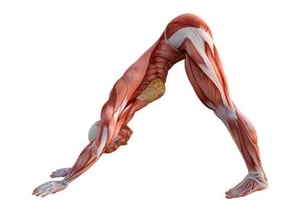Last updated on January 27th, 2023 at 02:36 pm
What should yoga teachers know about the fascia?
When you are a yoga professional, you should try to look for more connections between spirituality and the body, and more ways to connect with your students and clients. The knowledge about the human body is something you should always explore and expand. This is how you can come face to face with any concerns your students may have.
One of the best aspects of this approach is to listen to what your clients have to say and help them with their poses. If you help them make the necessary modification and ease them into each pose, you will show them that you want to keep them safe.
It does not matter if it is a private lesson or a collective class. Remember, they are there to increase their strength and flexibility and achieve a certain goal. Your job is to support them every step of the way.
This is why the focus of today will be put on the fascia. How can it help you, support you, and what it means to know something more about it?
Your fascial system; everything you need to know about it!
This tissue connects every part of the body, without any exceptions. This means that the fascia can be found in every tissue, blood vessel, bone, organ, nerve, muscle, etc. It also has a great effect on the neurological system and muscular systems too.


It is why it is an important aspect of your life and your body
Simply put, fascia is like a biological fabric that holds us together. It is composed of a dense network of fibres. In essence, it contains collagen fibres (meaning that the fascia provides support and strength), elastic fibres (meaning that the fascia offers the ability to change), and it provides ground substance (this is known as a gelatinous substance that helps smooth the work of muscle and organs without any damage or friction.
The two most common types of fascia are the superficial one – which is located right under the skin’s surface, and the tougher one, found in a tighter form. The second one is a part of the blood vessels, muscles, and so on. Finally, there is a third type of fascia that makes our body stable and ensures that all body functions go as smoothly as possible.
The importance of maintaining a healthy fascia
Fascia is the organ that contributes to our form. This is the thing that drives us, keeps us moving forward, and makes us who we are. It is often linked to the word ‘connection’, and people have increasingly started understanding its importance.
This is why it is highly important to maintain a healthy outlook and try to keep yourself active. It is the best way to help maintain a healthy fascia. We have come to the one support system that can do wonders for the fascial network, and it is yoga. Let’s take a look at how it would help.


How does yoga affect the fascia?
Yoga and fascia are other subjects that we would love to touch upon, especially because there is a great connection between the two. Through yoga, along with a healthy dietary plan and a clear mindset, you can achieve a fascial release. It will help you eliminate soreness and help the tissue recovery process. That being said, here is more on the benefits of practising yoga to improve your fascia.
Support the fascia
– if you want to maintain a happy outlook, then think of it this way – enjoying a happy fascia is the way to go! This will result in a fluid and spiritually strong connection with your body. You can notice it while you exercise and do regular activities such as walking or climbing stairs. You will see that you are doing it with such ease!
Healthy joints
– while we are on the subject of joints, yoga and fascia can do wonders for the body. All the tendons and ligaments, which are part of the human body, and the connective tissues, get tight whenever you are met with stress or an injury. Keeping the body mobile means keeping the body happy. This is why it is recommended to stretch the body slowly but efficiently. The ligaments and the tendons will relax, and you and your students will enjoy deeper flexibility.
Posture is incredibly important
– this comes to light as soon as you start practising yin yoga, which is all about balancing your posture. The fascia affects our posture, and everything we do to help it affects our posture too. Tension can spread throughout the body, and when the body is not fluid, restriction of movement may occur. This is why yin yoga has been incredibly beneficial in fixing posture and making you feel and look good.
Improving the brain
– fascial release can also help the brain chemistry! It can help release all the accumulated negative energy during the day and give the body and mind the needed flow. Brain chemistry is important, so nurture and get the most out of it.
A spiritual connection
– using your fascia and teaching your students how to use it is the best way to discover a heightened sense of self. It is the ultimate body-mind connection, and it can contribute to functioning on a day-to-day basis. Since the fascia affects emotions and thoughts, we advise you to nurture it.
Create the space for yourself and show your students how they can create a space for themselves too! Make them feel warm, welcome, and caring to have a sense of comfort and stability. Show them the various poses through which they can elevate their health and change themselves for the better. Nurturing the fascia is the way to do it. And when they do poses that promote the fascial release, they will adore it!

If you want to discover more about how yin yoga can help you guide through this process, head over to our yin yoga teacher training page.
